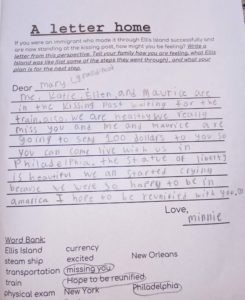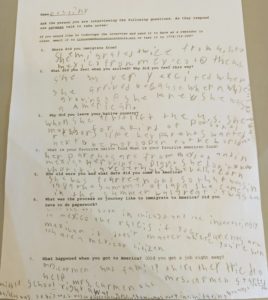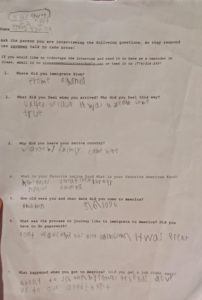Unit Wide Learning Goals
- Students will be able to define who an immigrant is and why they may leave native country.
- Students will be able to describe immigration process as it took place on Ellis Island.
- Students will be able to describe the basics of the immigration process today.
- Students will be able to identify how the immigration process has evolved over time.
- Students will be able to identify the feelings with immigrants of the past and present.
Lesson one: Who is an immigrant?
- SWBAT define immigrant int their own written words.
- SWBAT articulate why people leave their native countries.
- SWBAT see where people immigrate to/emigrate from on a map.
Activity:
During this lesson students were read the book, Coming to America. Throughout the book we stopped as a class to fill in the slides which can be found here. Following this read aloud students responded to the question “Who is an immigrant? Why might they have left their native country?”
Student Work Samples:
“An immigrant is that they have to leave their country and come to a new land to make new homes. The cause of an immigrant to leave their country is that natural disasters form or maybe a war will happen, also they were forced to leave their country.”
“A immigrant is a person who moves from one country to another country.A immigrant moves to another country for a reason for example a immigrant can move to another country is because war, natural disasters, and slavery or to have a better life and a better home, and a safer country to live in than a dangerous country”
Lesson two: Ellis Island Exploration
- SWBAT feel empathy for the immigrants who entered Ellis Island.
- SWBAT write about what an immigrant may have been feeling during each stage entering Ellis Island.
- SWBAT understand the multiple steps it took (most) immigrants to enter Ellis Island
Activity:
For multiple days the students and I spent time exploring an interactive website which walked through the many steps of Ellis Island. During these lessons students exploration would also be supported by slides and completion of an empathy journal (both of which can be found here). At any point during this many day lesson students were encouraged to ask write down questions and post them on the question board.
Student Work Samples:

This is an example of a student showing they were listening to the lesson because the student is shocked by the fact that immigrants had to stay on the boat they arrived to Ellis Island on if they were in steerage. This question also told me that this is a topic which I need to reteach.
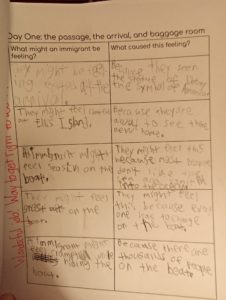
This student was able to identify multiple different feelings at different point along the Ellis Island Journey and identify their source.
Lesson three: Immigration Simulation
- SWBAT relate emotionally to those who were processed through Ellis Island.
- SWBAT list at least two barriers to entering the United States through Ellis Island.
- SWBAT connect the steps in the America simulation to the steps immigrant had to complete to be allowed access to the United States through Ellis Island in 1910.
Activity:
During this lesson students were given a “passport” as a form of instructions, activities, and assessment. Students were placed into family groups, assigned identities, and were let loose to proceed through the stations, all of this you can see here.
Student Work Samples:
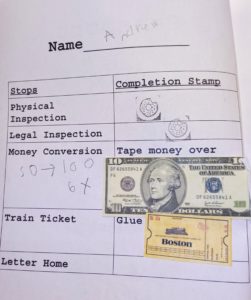
This is an example of a student who completed each station. This is the type of checklist the students were asked to fill in.
Lesson four: No Question Left Unturned
- SWBAT partake in turn and talks to make educated guesses and answer their own questions.
- SWBAT share what they believe they know about present immigration based on prior knowledge.
- SWBAT create further questions spawned from the information they gained during this lesson and previous lessons.
Activity:
This lesson was not originally planned in the design of the unit, however after watching the students overflow with on topic questions I decided that we needed to design all of the questions. The students participated in active discussion and turn and talks to attempt and their own questions. To see the slides which compiled and answered many of the students questions look at the third set of slides in the column titled Immigration lessons: Slides.
Lesson five: Immigrant Interview
- SWBAT create a list of interview questions as a group.
- SWBAT conduct an interview and record answers using specific tips.
- SWBAT describe what the immigration process looks like in present day.
Activity:
During the school day I introduced the students to the basics of interviewing someone, then together we created an interview. That night the students brought home the interview to complete with an immigrant in their life. For those students who did not have an immigrant to interview, I had recorded the same interview to interview an immigrant in my own life for them to use as a resource.
Student Work Samples:
Lesson six: Clips Presentations
- SWBAT choose appropriate pictures and create a Clips script.
- SWBAT create a Clips presentation answering essential questions.
- SWBAT present the information they learned about through conducting their interview in writing and verbally.
Activity:
During this lesson students were shown how to use a program called Clips. This program allows students to choose related pictures and record themselves speaking. The students would choose a picture which related to each interview question and retell the story of the person they interviewed.

